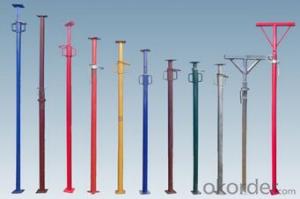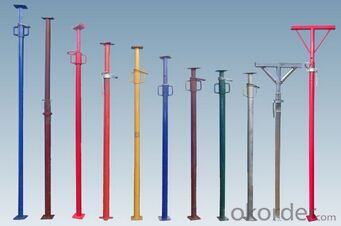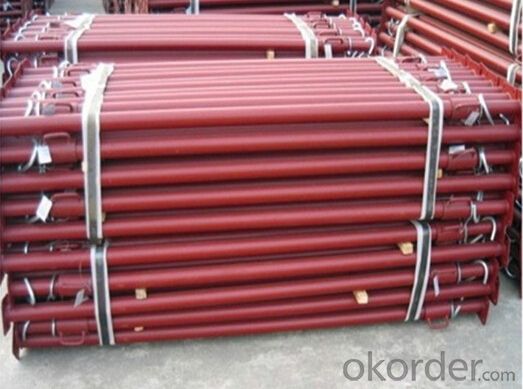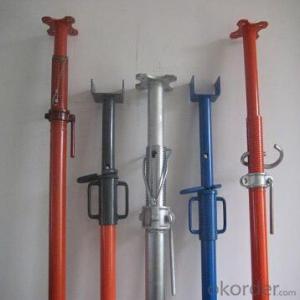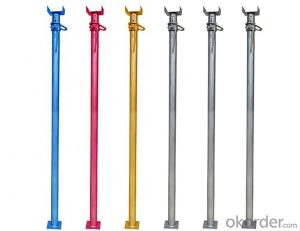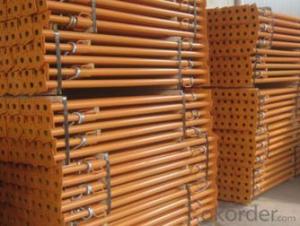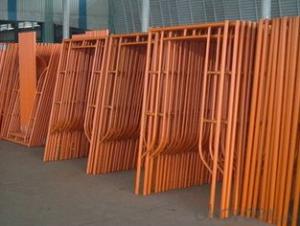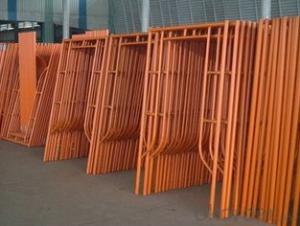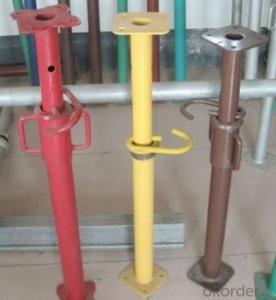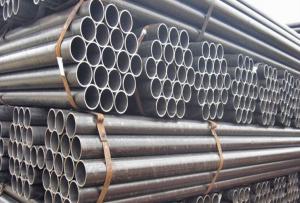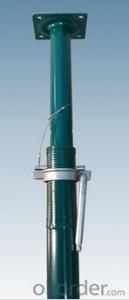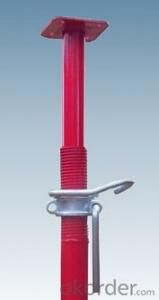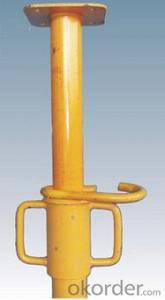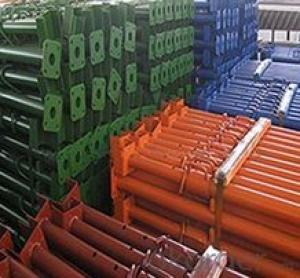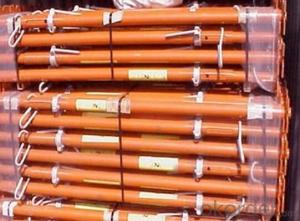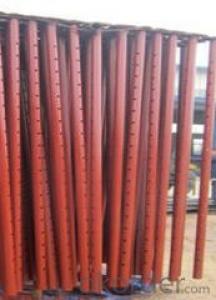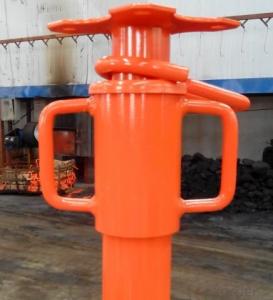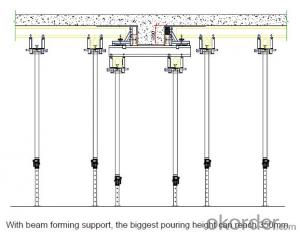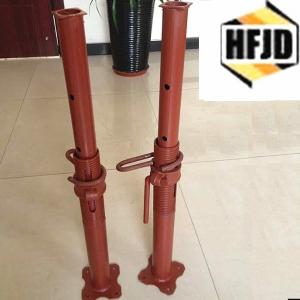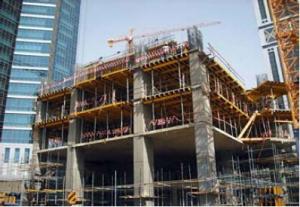Scaffolding pipe support system steel props
- Loading Port:
- China Main Port
- Payment Terms:
- TT OR LC
- Min Order Qty:
- -
- Supply Capability:
- -
OKorder Service Pledge
Quality Product, Order Online Tracking, Timely Delivery
OKorder Financial Service
Credit Rating, Credit Services, Credit Purchasing
You Might Also Like
Quick Details
| Place of Origin: | Name: | ||||
| Adjustable Size: | Thickness: | Finishment: | |||
| MOQ: | Delivery Time: | Payment Term: | |||
| Business Type: | Color: | Location: |
Packaging & Delivery
| Packaging Detail: | In bundle or in bulk or as your request,normally in bulk can be loaded 1800-2500pcs for different size in one 20ft container. |
| Delivery Detail: | 10 to 30 days after order confirmation |
Specifications
construction props
1)Manufacturer 10 years ;
2)OEM offered,
3)Formwork,beam,concrete,slab support,
4)Promptly delivery.
| Name | construction props |
| Place of Origin | Guangzhou China |
| Brand name | Shuangma |
| Size | Ø40- Ø48/Ø48- Ø56 or as your request |
| Main Material | Q235, Q195 |
| Surface Treatment | High Protected Painted, Powder Coating, Electric Gavenized, Hot Dip Gavenized. |
| Color | Silver, red,orange |
| Certificate | SGS, |
| Service | OEM Service available |
| MOQ | 500pcs |
| Payment | T/T |
| Delivery Time | 10-30 days after confirmation |
| Packing | In bulk or steel pallet or as your request |
| Production capability | 200 tons per day |
- Q: Can steel props be used in the construction of temporary religious or worship structures?
- Yes, steel props can be used in the construction of temporary religious or worship structures. Steel props provide sturdy support and can withstand heavy loads, making them suitable for temporary structures such as tents or temporary worship spaces. They offer stability and safety, ensuring the structure is secure and reliable during religious and worship activities.
- Q: Can steel props be used for temporary support during suspended ceiling installation?
- Yes, steel props can be used as temporary support during suspended ceiling installation. Steel props are strong and sturdy, making them suitable for providing support and stability during the installation process. They can be adjusted to the desired height, ensuring a secure and reliable temporary support system for the suspended ceiling.
- Q: Are steel props suitable for supporting temporary bridges or walkways?
- Yes, steel props are suitable for supporting temporary bridges or walkways. Steel props are strong, durable, and capable of bearing heavy loads, making them a reliable choice for providing structural support to temporary structures like bridges and walkways.
- Q: I would like to ask the steel support line load is 420kn/m (design value), 20 meters deep foundation pit, steel support diameter of 609, wall thickness of 16mm
- So, what you said is the foundation pit excavation, pipe ends supporting, then why have load and steel 420kN/m?Do you want to build a house above the shop?
- Q: Can steel props be used for scaffolding purposes?
- Indeed, steel props have the capacity to serve as scaffolding aids. Referred to as adjustable props or steel acrow props, these sturdy steel devices are frequently employed in construction and building endeavors to bolster and ensure the stability of provisional structures, such as scaffolding. Constructed from resilient steel materials, they possess the ability to withstand substantial loads and furnish a solid foundation for scaffolding. Notably, these steel props can be flexibly modified to accommodate different heights, and their installation and disassembly processes are straightforward, rendering them a dependable and effective option for scaffolding applications.
- Q: Can steel props be used in residential construction projects?
- Residential construction projects can utilize steel props for vertical support. Steel props, also known as adjustable steel props or steel shores, are temporary supports that provide stability to structures during construction or renovation. They are commonly employed in residential construction to support load-bearing elements like beams and walls. Steel props are favored in construction due to their strength and adjustability. They can be easily modified to the desired height and offer stable support for heavy loads. Typically constructed from high-quality steel, they guarantee durability and the ability to withstand heavy loads. In residential construction, steel props can be utilized in various scenarios. For instance, they can support temporary beams during the installation of new windows or doors, reinforce walls during demolition or renovation, or uphold the weight of a temporary roof structure while constructing a new floor. Moreover, steel props are versatile and can be adjusted to fit different heights and angles, making them suitable for a wide range of applications in residential construction. Their quick installation and removal save time and effort during construction projects. Nevertheless, it is crucial to note that the use of steel props should be handled by professionals with the required knowledge and experience to ensure safe and proper installation. Improper utilization may result in accidents or structural failures, which can be hazardous and costly. In conclusion, steel props are an effective solution for temporary support in residential construction projects. Their strength, adjustability, and versatility make them a reliable choice for supporting various load-bearing elements. However, it is vital to ensure that qualified professionals install them correctly to guarantee safety and avoid potential risks.
- Q: How do you install a steel prop?
- To install a steel prop, start by positioning the base of the prop on a stable and level surface. Extend the telescopic sections to the desired height, ensuring that the prop is securely locked in place. Make sure the prop is plumb and supporting the load evenly. Finally, tighten any adjustable components to provide additional stability and support.
- Q: What are the guidelines for the proper installation and removal of steel props?
- To ensure safety and effectiveness, there are several key steps involved in the proper installation and removal of steel props. Here are the general guidelines you should follow: 1. Before you begin installation, assess the site conditions to ensure they are suitable for steel props. Check for any potential hazards or obstructions that could affect the process. 2. Select the appropriate type and size of steel props based on the load-bearing requirements and the height of the structure being supported. Make sure the props are in good condition and free from any defects or damages. 3. Start the installation by placing the base plate of the steel prop on a stable and level surface. Ensure the prop is vertical and aligned with the load-bearing point. Adjust the inner tube to reach the desired height and secure it by tightening the locking pin or collar. 4. Distribute the load evenly across the prop's base plate. Use timber or steel sole plates if necessary to spread the load over a larger area. This prevents excessive pressure on the ground or floor. 5. Enhance stability by using diagonal bracing or ties between the steel props and the supported structure. This helps prevent lateral movement or collapse in case of unexpected forces. 6. Regularly inspect the steel props during the installation process to identify any signs of instability, bending, or damage. Take immediate action to rectify any issues or seek professional assistance. 7. When removing the steel props, gradually reduce the load on each prop to avoid sudden shifts or collapses. Loosen the locking pin or collar and slowly lower the prop's inner tube in a controlled descent. 8. After removal, inspect the steel props for any damages or wear. Clean them thoroughly and store them in a dry and secure location to prevent rust or deterioration. Regularly maintain and service the steel props to extend their lifespan. Remember to follow the manufacturer guidelines and local regulations specific to your region when installing and removing steel props.
- Q: Are steel props suitable for supporting temporary towers?
- Yes, steel props are commonly used and well-suited for supporting temporary towers. They offer robust strength and stability, making them reliable for various construction and temporary structure applications.
- Q: What are the different types of steel prop pins and clips available?
- There are several types of steel prop pins and clips available, including sleeve pins, swivel pins, drophead pins, wedge pins, and connecting clips. Each type has its own unique design and serves a specific purpose in supporting and securing steel props in construction and formwork applications.
Send your message to us
Scaffolding pipe support system steel props
- Loading Port:
- China Main Port
- Payment Terms:
- TT OR LC
- Min Order Qty:
- -
- Supply Capability:
- -
OKorder Service Pledge
Quality Product, Order Online Tracking, Timely Delivery
OKorder Financial Service
Credit Rating, Credit Services, Credit Purchasing
Similar products
Hot products
Hot Searches
Related keywords
